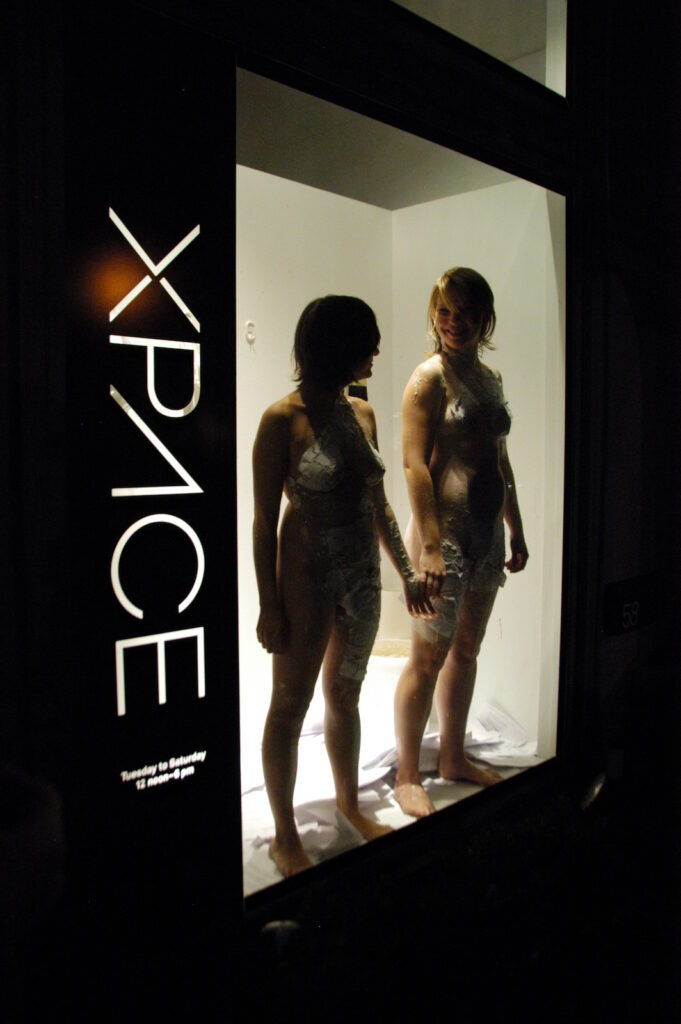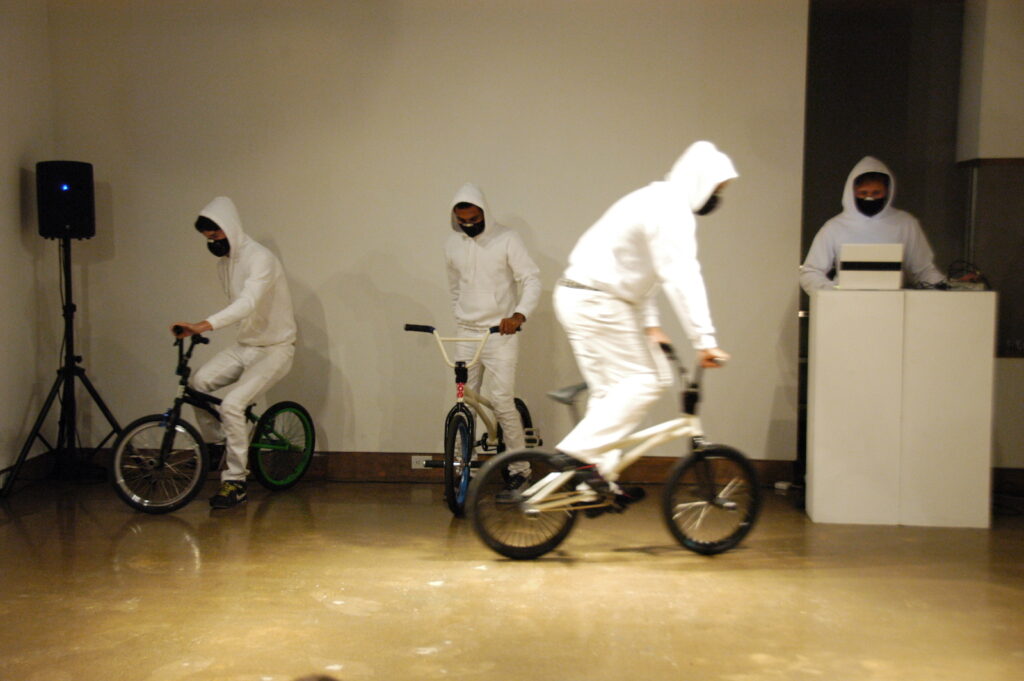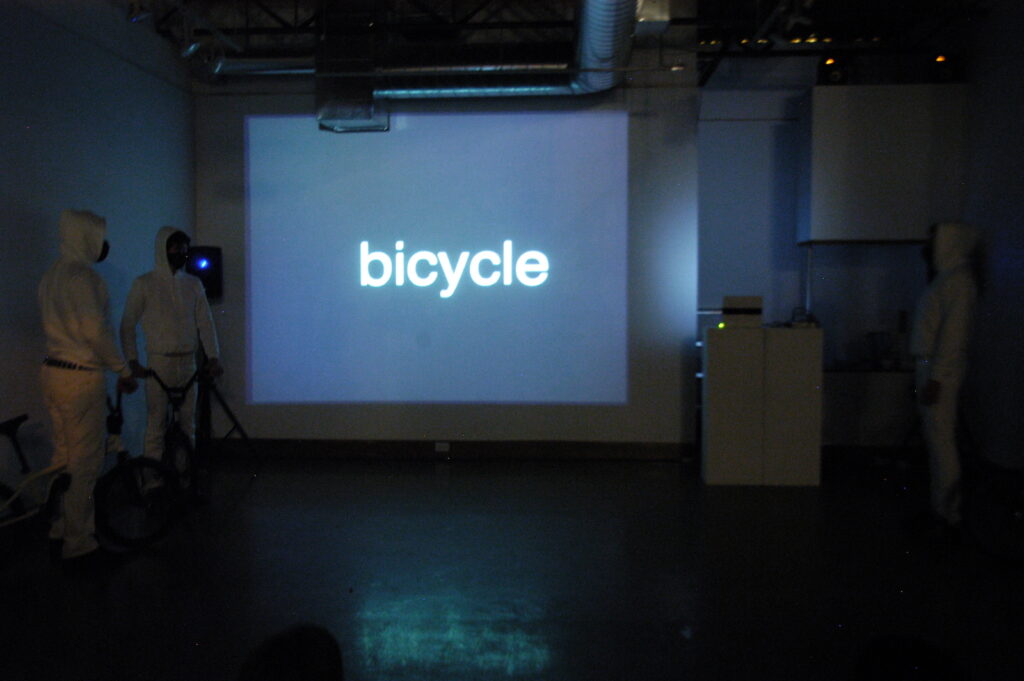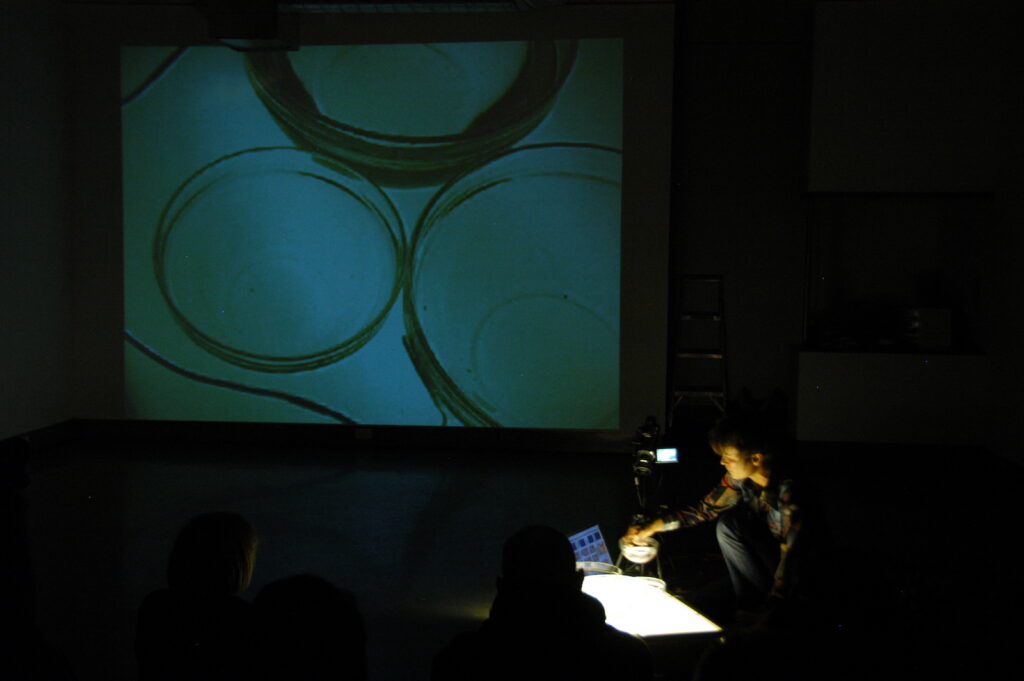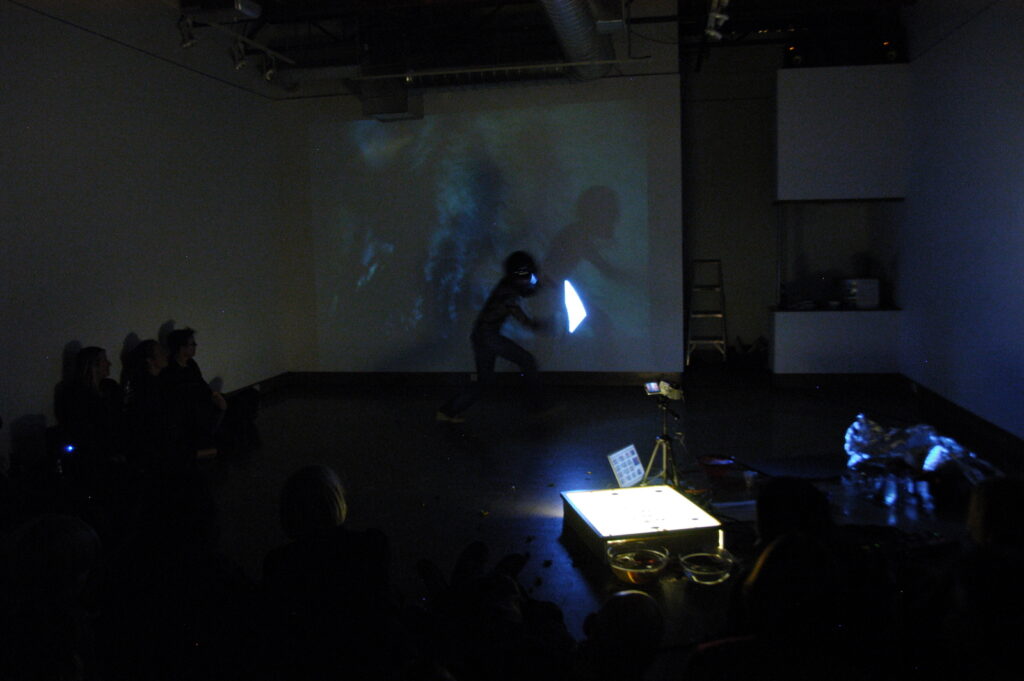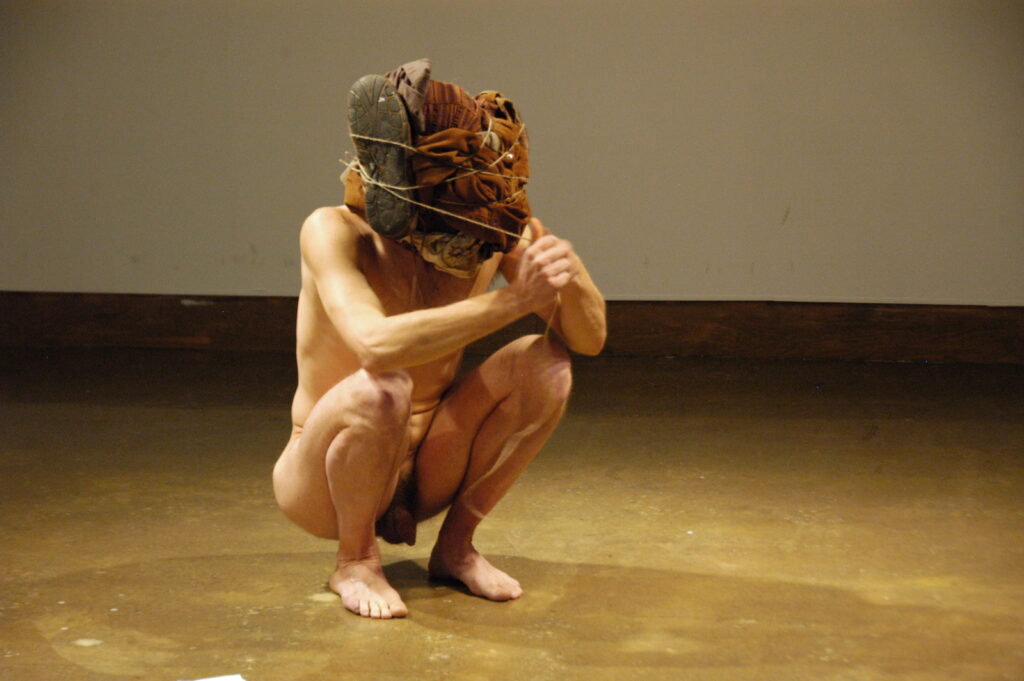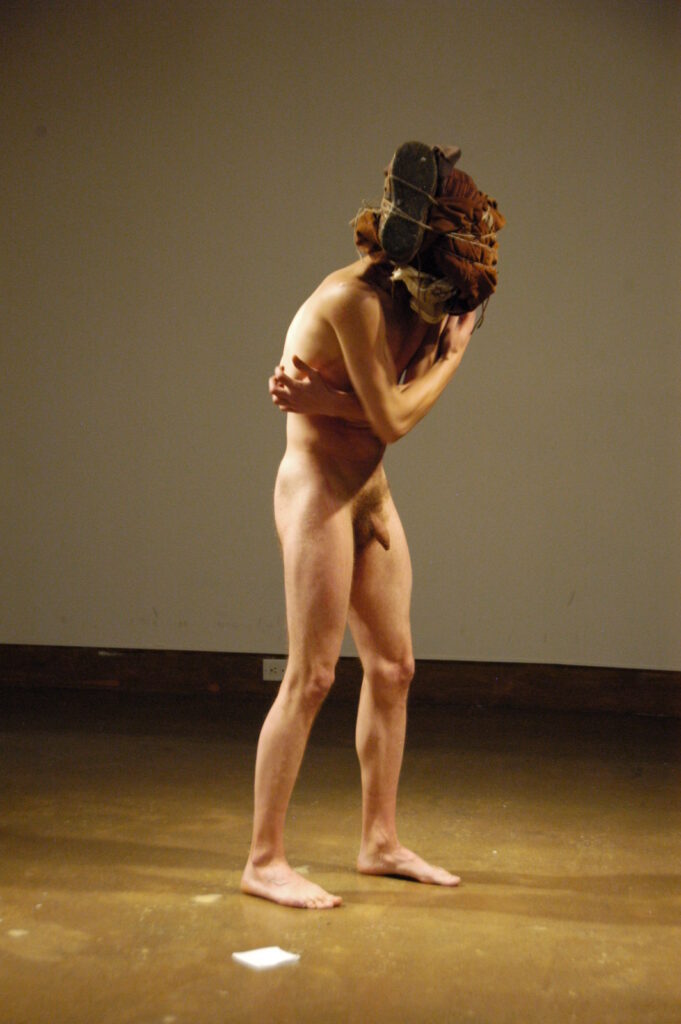By Andrew James Paterson
At twelve noon sharp, Robin Poitras presented an outdoor performance on a lovely pre-Halloween afternoon in downtown Toronto’s financial district. Poitras formed a trio with two other female artists—Brenda Cleniuk and Leanne Lloyd (both from Regina). Dressed in identical black outfits and wearing comfortable red shoes, they held umbrellas over their heads in unusually sunny weather and fastened belts hosting bells around each leg. The three-piece orchestra would sit in wooden stools in different site-specific arrangements and shake their bodies enough so that the bells would ring harmoniously. The ringing was particularly sonorous at the performance’s first location—in front of the Design Exchange (which had originally been the stock exchange). The ringing commenced at noon—high noon. Ringing bells of course carry many associations—meeting time, feeding time, mess time as it is called in the military. The stock market’s daily opening is announced by ringing bells, as is its daily closing. The stock market has of course been oscillating quite wildly in recent times—the stock market has been downright Fluxist.
The closer the performers could sit to each other, the more harmonious the bells. In front of the Design Exchange they were in one of my favourite keys—that of D, and the performers’ movements synchronized wonderfully. When the performers moved across the street to a deserted fountain area, they had to sit further apart from each other and some of the intensity was lost. But they could sense this so they picked up the slack, enough to attract the attention of a security guard who requested that they relocate. He had been dispatched to remove them from the property, but a compromise was achieved. Therefore, Poitras and her collaborators moved up to another level, and then they walked through them lobby of a large CIBC bank. Would they disturb that peace? (On an earlier day this week, another 7a*11d artist—Sakiko Yamaoka—did conduct or lead a sleep-in in various banks, including this one.) No, but people did stare. Perhaps the three women belonged to some religious cult? Or maybe a band? The three performers were definitely on their way to somewhere—they walked with intention.
In the evening it was time for another series of performances at XPACE. Prior to the indoor (and window) performances, there was a nicely intimate piece by Jason Lim outside the gallery. I missed the beginning, but when I arrived Jason was unspooling (de-spooling?) a roll of industrial strength black string. He was standing on six glasses. Opposite Jason, Norbert Klassen was unspooling a red spool, not standing on six or any number of glasses. This continued for a while, and I looked at the papers and props set up in the gallery window in anticipation of a scheduled performance by Natasha Bailey and Danielle Williams titled seen unseen. When I turned around to see Jason Lim’s performance, Norbert had excused himself and Jason’s black string was inter-threaded with red string. As I so often do with relatively informal durational performances, I walked elsewhere while intending to return later. When I returned, Jason was now wearing the mass of black string as a shaggy, almost Rastafarian wig over his eyes and he had a string with leaves dangling onto the ground from his upper body. His balance gradually became precarious and he eventually lost his footing from two of his foundation glasses. Thus the performance had to conclude.
After watching Natasha Bailey and Danielle Williams mouthing something sweetly inaudible to each other in the window while wearing sparse scraps of paper taped with some Plaster of Paris-like and gooey substance to their bodies, a performance by Toronto-based Don Simmons was announced.
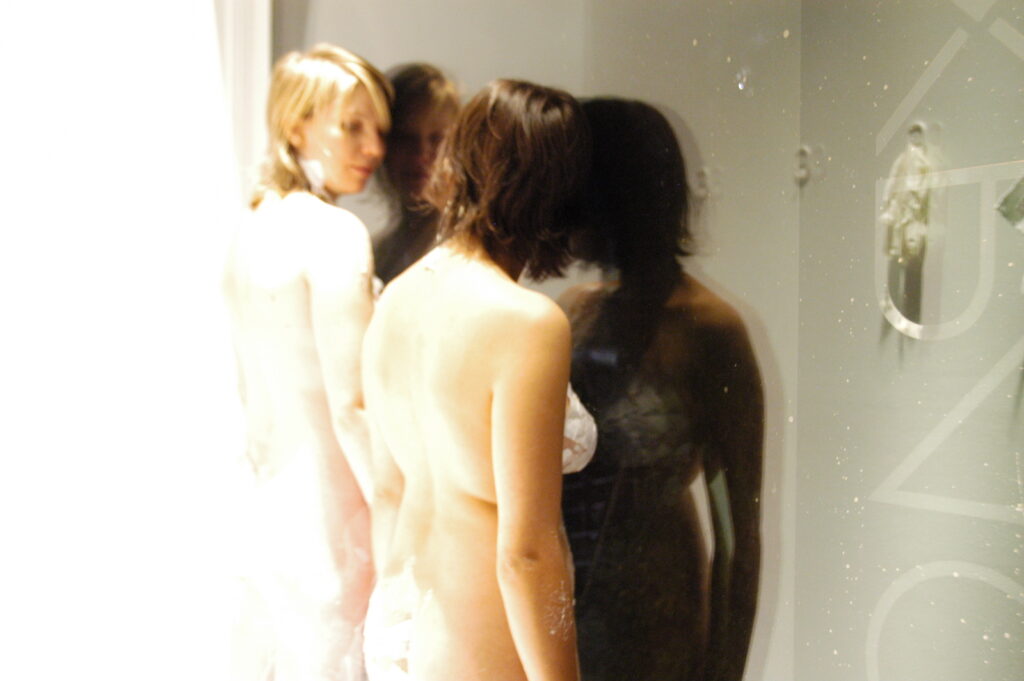
A man whom I recognized as Simmons stood behind a laptop on a plinth and a sound collage began. Simmons was wearing a white athletic suit with a hood and a black cloth over his mouth. Three bicyclists entered from the street door, identically dressed with Simmons and with each other. The cyclists rode toward the audience together, and then in competition with each other. They took turns at one-upmanship, riding like skateboard kids, riding like motorcyclists with their wheelies and whatnots.
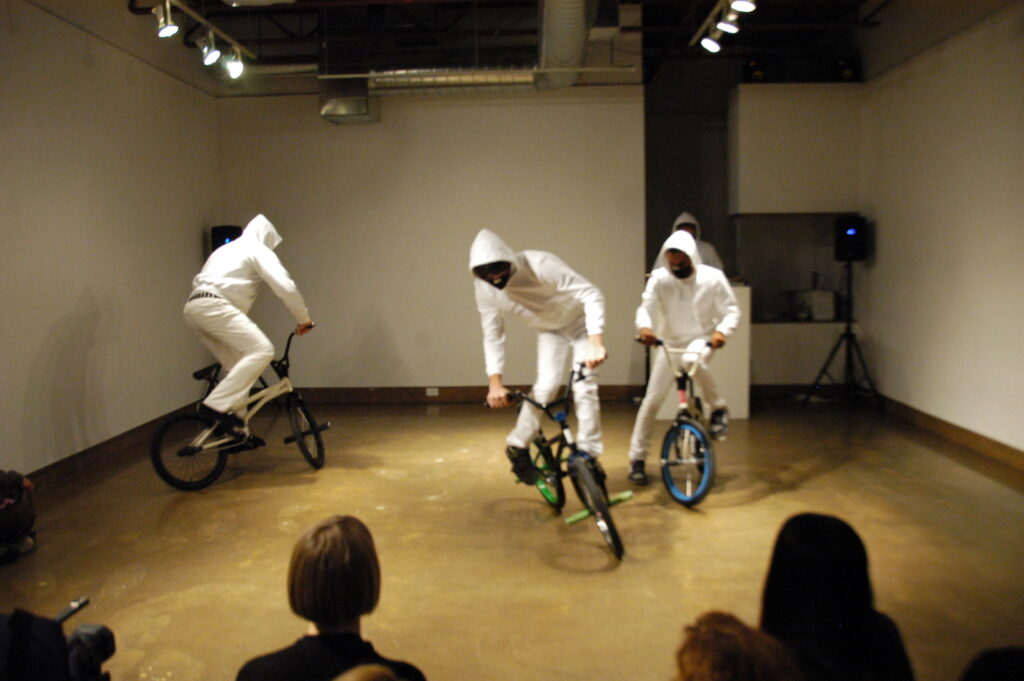
Simmons’ sound collage was richly detailed. He combined motor and crowd noises, and an interesting dislocation or distance developed between the prerecorded crowd reactions and those of the audience, who were somewhat amused but impressed with the riders’ agility. But the riders came closer and closer to wiping out, and then the lights went down. So did the sound—completely down and off. A text was projected—a rather lengthy text acknowledging the ongoing bicycle fatalities on Toronto’s and other streets and spoken from the perspective of somebody committed to the group Advocacy for Respect for Cyclists, or ARC. The text indicates that the speaker dutifully attends memorials for fallen cyclists, even though he does not know any of the dead. Whatever, he still feels a need to be there. The contrast between the live and dangerous and the elegiac in Simmons’ performance was considerable, and it was the prime intention of this performance. There was an effective contrast between what was live and vulnerable, and what it was like to be sitting in a movie theatre and taking in plot and/or information with the lights down and everything confined to the screen. Simmons’ performance was titled Picked you out of my pocket and death was the door prize. The door prize is an award given to motorists who violate a cardinal road rule and fail to look before opening their vehicle doors.
The next performance was by Helsinki-based Sini Haapalinna, who crouched on the floor in front of a surface containing various objects and also in front of a small video camera. There was a screen on the wall behind her. She began placing objects in the camera’s field and playing with them, creating moving pictures. She also would make sounds with various objects and play the sounds against the pictures. Sini was highly skilled at layering images. She performed an extended section with a simple water bowl that she could multiply and alter the textures of by playing with the camera but also water itself—skimming it and even splashing it a little. She blew bubbles into the water bowl and achieved a wonderful lava-like texture. She used filters or screens, she moved like a slow dancer in front of the screen with LEDs after setting enough images and sound in motion. She added parts on top of added parts. Much of her performance—KALEIDOSCOPOPSPECTACAL—consisted of layering parts (both sight and sound) in top of already added sounds and then finding another object to explore—to see how it might generate images and sounds. The effects were often striking, but the performance did go on for too long.
The final performance was by Berlin-based BBB Johannes Deimling, in collaboration with FADO Performance Art Centre of Toronto. This untitled performance was very effective due to its relative simplicity. After announcing that only members of 7a*11d could document his performance, Deimling stood centre playing area and began systematically removing his garments. He would blindfold himself with his clothes, wrapping them around his head like a bath towel or a turban or some bizarre head gear (bizarre because it was comprised of very ordinary or everyday clothing.) He took off his shoes, he added his socks to the head contraption, and he even added the shoes after taking off his underwear (and wrapping it around his head). His body was naked, but he was also wearing a seriously cumbersome head-dress.
Then he began scrubbing his body, like a person showering but with nails. The scrubbing or cleaning accelerated into scratching. He scratched harder and harder and drew what looked like welts as well as bleeding. When he had scratched to satisfaction or his limit, he used a tissue to stop the bleeding and to wash off his body, to soften or restore it. Then he placed the tissue on his left little finger and struck two poses. Then he handed the tissue to the nearest audience member, who happened to be Sini Haapalinna. The performance and the evening were now complete and concluded.
This evening of course being Halloween, there was occasional confusion about who was a performer and who wasn’t during the changeovers or intermissions. This was fun—it was amusing. But no trick and treating pour moi. I had to get home and get to work, and then get to sleep.


